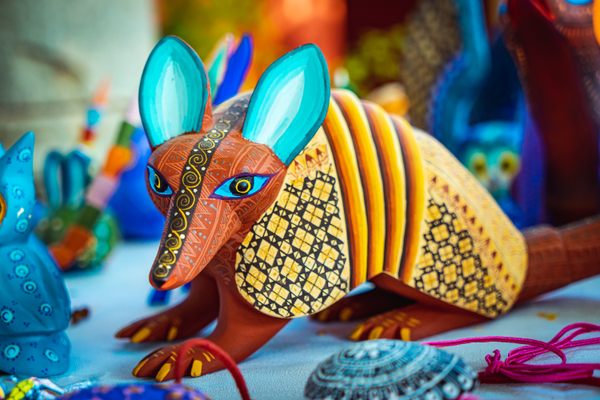
How These Bull-Shaped Billboards Became Spanish Icons
Once an advertisement for brandy, the Osborne bull is now a symbol of the country.
The landscape of the Spanish countryside is distinctive. Roads are surrounded by fields of grain, olive trees, and cork oaks. There are a few sparse villages, and no humans in sight. Instead, white storks are abundant, with their nests built on top of the electric poles that flank the roads. And then, every few hundred miles, the silhouette of an enormous black bull emerges against the blue sky.
Each bull is 46 feet high and weighs 10,000 pounds, and there are currently almost a hundred of them scattered around the country. They were initially created as billboards to promote a new drink, Veterano brandy, but today, more than six decades after it debuted, the “Osborne bull” has become an iconic emblem of Spain. And the bull owes part of that success to a family of blacksmiths that has been taking care of the billboards since the 1960s.
The first bull was installed in 1957 in Cabanillas de la Sierra, some 40 miles north of Madrid to advertise the new product from the Osborne company which was based El Puerto de Santa Maria in southern Spain. Stockbreeding of fighting bulls is relatively common in that region and the animals were seen as manly and virile, concepts that the company wanted to associate with their brandy. The first bull was about 13 feet high and made of wood with the words “Veterano Osborne” painted in red letters next to a brandy glass. But this wooden billboard and others that were built soon after were too frail to withstand the country’s weather conditions. In 1961, they were replaced by metal bulls about three times the size of the originals.

To Sara Herrero, an expert in publicity at the University Jaume I who has studied how Spanish advertisements contribute to and reinforce the country’s identity, the enormous Osborne bulls made their appearance at the perfect time. “In the 60s, during Franco’s dictatorship, Spain began to open up to the world and touted itself as a place for sun-and-beach tourism, gastronomy, flamenco music—and bullfighting,” Herrero explains.
By the 1970s, there were more than 500 bulls across the country, and the Osborne bull was on its way to becoming Spain’s unofficial symbol. In 1972, the New York Times Magazine chose a picture of an Osborne bull for its cover to illustrate a piece on how Spain was changing as the end of Franco’s dictatorship approached. Later, companies began to show the bulls in commercial spots and movie directors featured them in their films; an Osborne bull is visible in the background of a famous scene of the 1992 film Jamón, Jamón, featuring Javier Bardem and Penélope Cruz.
The love Spaniards have for the Osborne bulls became even more evident in the 1990s, when the government passed a law prohibiting billboards along Spanish roads, as the signs could distract drivers and lead to accidents. Anonymous citizens, regional governments, and public figures demanded an exemption for the Osborne bulls. Encouraged by the public support, the company removed all the words from the bulls and decided to keep them on the roads, arguing they could no longer be considered billboards. They were fined, and they appealed the decision. Finally, in 1997, the Supreme Court ruled that the bulls could remain, as they had “ceased to be the emblem of a brand to become something decorative, integrated in the landscape.”

Ivan Llanza, director of the Osborne Foundation, an organization founded in 2016 to manage the company’s heritage, says that despite no longer bearing its product’s name, the bulls still have strong ties with the company from which they originated. “The bull is still a bull with a surname: the Osborne bull,” Llanza says.
Osborne owns the copyright to the design and is also responsible for the maintenance of the bulls. But Llanza agrees that their significance today goes beyond the original commercial purpose. “They are now part of the collective mind of the country,” he says. “As children, we’ve all grown up counting bulls during our road trips.”
The visibility of the bulls and their societal significance have also made them a perfect target for political and artistic interventions.

In Catalonia, a region in northeast Spain with a strong independence movement, the bulls had to be removed in the early 2000s because they were constantly vandalized by people who saw them as a sign of Spanish domination.
Other activists were more creative. In 2017, a bull near the city of Santa Pola was turned into a version of the Guernica, the famous anti-war painting by Pablo Picasso. And in 2011, a bull on the Spanish island of Mallorca was painted with a rainbow flag, a symbol of the LGTB movement. More recently, an artist painted the bull in A Limia in light blue. The effect was such that at certain times of the day the bull seemed to vanish, merging with the sky.
These changes usually don’t last too long. When a bull is damaged, the Osborne Foundation calls the Tejadas, three brothers who own a small blacksmith shop in El Puerto de Santa María. The family has been responsible for installing and repairing the bulls since the 1960s.

The three Tejada brothers–Félix, Jesús and Pedro—travel around Spain making sure that all the bulls are in perfect condition. Before them, their father and uncle did the same job. Pedro, who, at 56, is the youngest of the three brothers, says they started accompanying the older men on these trips when they were children. Later, the brothers took up the family business and the situation reversed.
“Even after he retired, my father often traveled with us to keep us company,” Pedro says. “He died at 81 and regularly came on our working trips until two or three years before he passed away.”
The brothers were recently in Tarifa, in the southernmost tip of mainland Spain, a region famous for being extremely windy. The bull there hadn’t been vandalized, but it was 37 years old and in such bad shape due to the strong winds that they had to replace it with a new one.

After a lifetime taking care of the bulls, the brothers have their preferences. Pedro likes the bull of Trujillo, located on top of some big rocks and perfectly integrated in the scenery. And he particularly enjoys the ones in La Mancha region, the land of the famous Don Quixote, where the bulls are often surrounded by sunflower fields. The bulls may get all the attention, but “the landscape makes the difference,” he says.
























Follow us on Twitter to get the latest on the world's hidden wonders.
Like us on Facebook to get the latest on the world's hidden wonders.
Follow us on Twitter Like us on Facebook